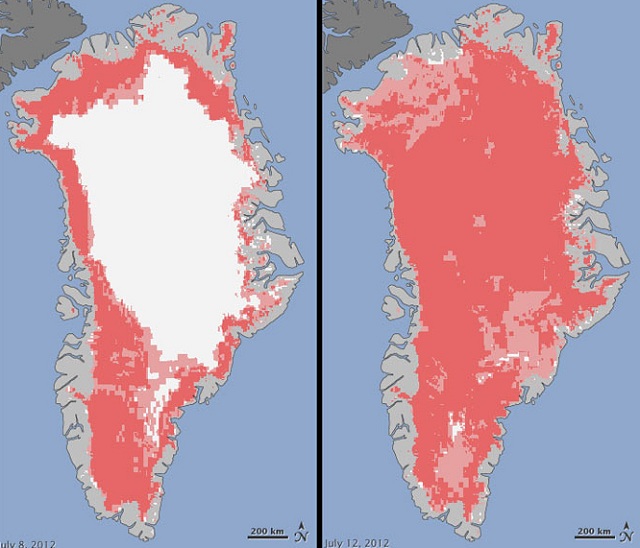Blink, it's gone: Greenland's surface ice melted 3 weeks ago

What a difference four days make. Greenland on July 8 (left) and 12. The white is surface ice.–
Almost all of Greenland’s surface ice melted in a 4-day period earlier this month, NASA satellite photos reveal.
From July 8-12, 97 percent of the top ice melted. Normally, Greenland loses about 50 percent of the layer over the course of a summer, much of which quickly refreezes.
A NASA press release notes,
For several days this month, Greenland’s surface ice cover melted over a larger area than at any time in more than 30 years of satellite observations. Nearly the entire ice cover of Greenland, from its thin, low-lying coastal edges to its two-mile-thick center, experienced some degree of melting at its surface…On average in the summer, about half of the surface of Greenland’s ice sheet naturally melts…But this year the extent of ice melting at or near the surface jumped dramatically. According to satellite data, an estimated 97 percent of the ice sheet surface thawed at some point in mid-July.
To illustrate the extent of the melt, NASA observed that even at 2 miles above sea level - the sheet’s highest elevation - ice “showed signs of melting.”
NASA released the photos a week after reporting that a Manhattan-sized chunk of glacier broke off from the N. Atlantic country and morphed into an iceberg.
This summer’s melt is the most pronounced in Greenland since 1889, Kaitlin Keegan from Dartmouth College notes in the press release.
So, is man made global warming the culprit? NASA glaciologist Lora Koenig notes that Greenland experiences such melting events, “About once every 150 years on average. With the last one happening in 1889, this event is right on time. But if we continue to observe melting events like this in upcoming years, it will be worrisome.”
As SmartPlanet reported earlier this week, NASA Goddard Institute for Space Studies director James Hansen - a staunch campaigner against man made global warming - is encouraging President Obama to back nuclear power as a C02-free, and thus eco-friendly form, of energy.
Hansen co-signed a letter that British billionaire Richard Branson sent to Obama pushing for support in commercializing an alternative nuclear technology called an Integral Fast Reactor, which he says is better and safer than today’s conventional reactors. Eric Loewen, the president of the American Nuclear Society and also the chief engineer for General Electric-Hitachi’s PRISM IFR, also penned the request.
This week’s NASA press release says the Greenland melt has “coincided with an unusually strong ridge of warm air, or a heat dome, over Greenland,” that was the latest in a series of ridges since the end of May.
That sounds to me as though it coincides with the jet stream meanderings that have wreaked havoc on weather elsewhere in the Northern Hemisphere this summer. Question: did CO2 emitting fossil fuels push around the jet stream, or did it move of its own natural accord?
You can return to the main Market News page, or press the Back button on your browser.

